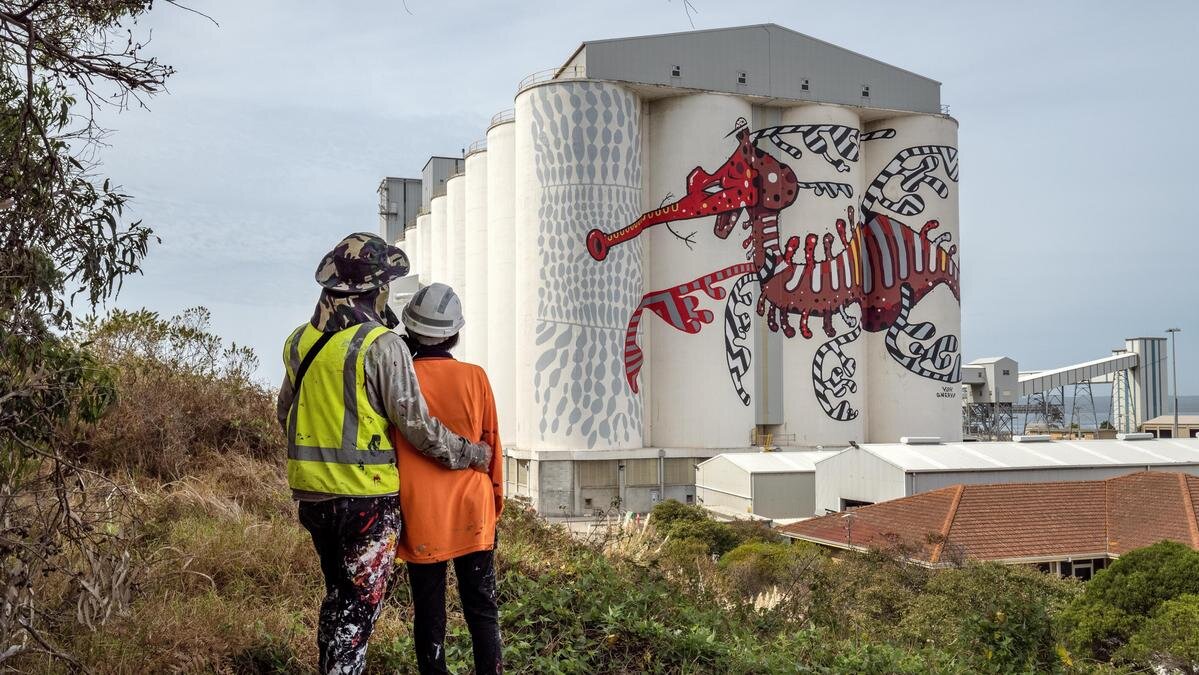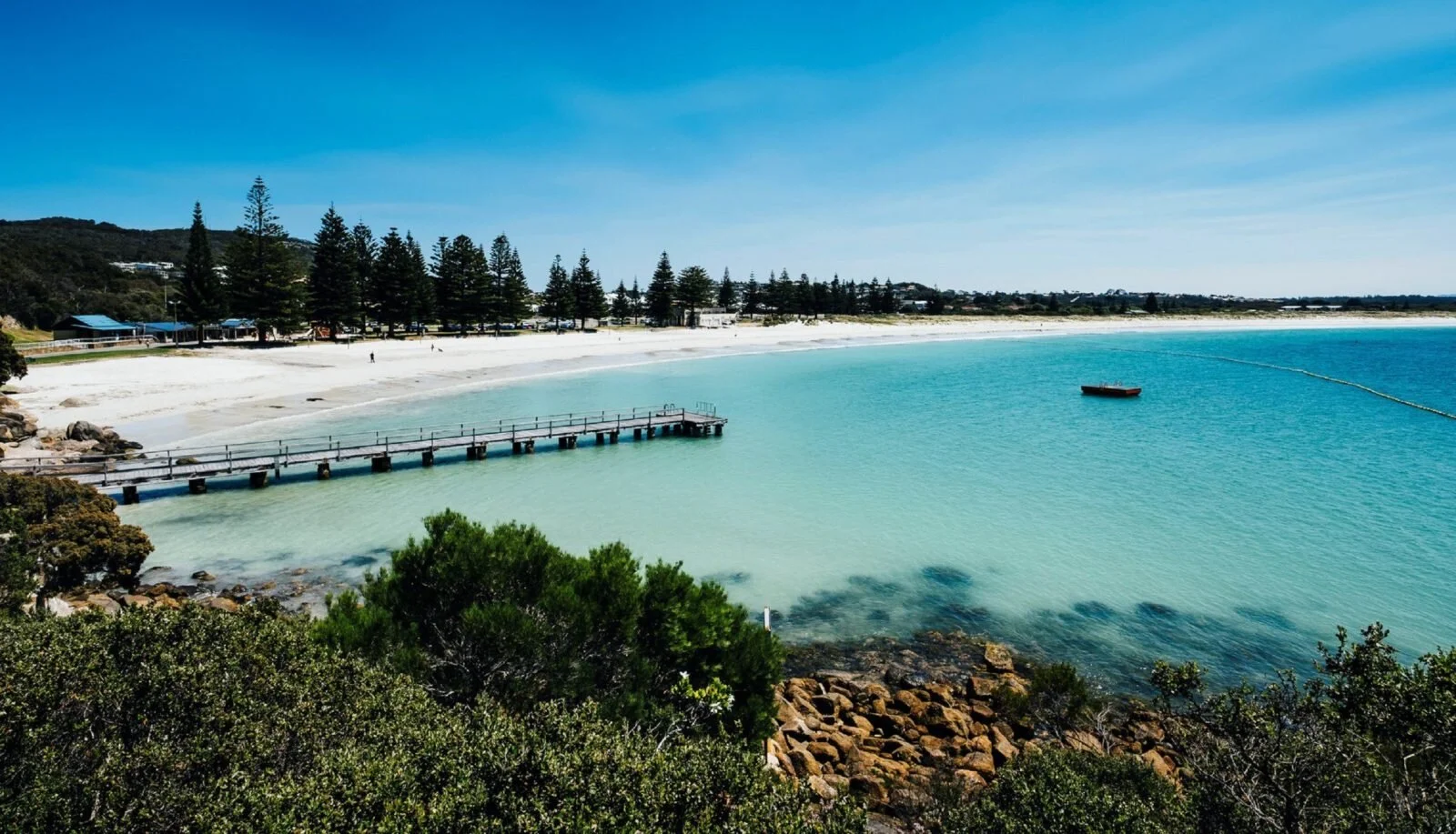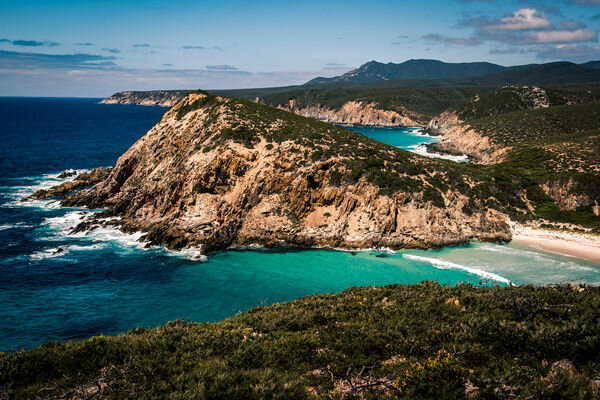Albany, West Australia
Outstanding Role in West Australian & ANZAC History
The South Coast of Western Australia stretches for 1,600 kms, from Cape Leeuwin (southwest corner of WA) to Eucla (close to the border with SA). The Albany Coast is one of four WA coastal regions (Leeuwin Coast, Albany Coast, Esperance Coast, Eucla Coast) fronting the Great Australian Bight. Occasionally marketed as the ‘Rainbow Coast’, the Albany Coast often experiences winter rainbows when the sun is at its lowest in mid-winter.
Charming Albany, pop approx 34,250, faces King George Sound - 420 kms southeast of Perth. Unlike most of Western Australia (which is generally hot and dry), Albany is mostly cool and wet. It’s a rather-sleepy town with a great deal of historical significance to WA. This is where the state’s first European settlement took place. Commander of the early outpost, a Major Edmund Lockyer, formally re-asserted possession of the western third of the continent for the British Crown (1827), forestalling French ambitions in the region.
Albany therefore is the oldest colonial settlement in the west - predating the Swan River colony of Perth/Fremantle by over two years. Prior to the opening of the Fremantle Inner Harbour in 1897, Albany (and King George Sound) offered the only deep-water port in the west, which was critical to shipping between the Australian east-coast colonies and the UK.
Explorer Edward John Eyre (with his aboriginal companion, Wylie) staggered into early Albany after their gruelling crossing of the Nullarbor (around the Bight) in 1841. Eyre stayed for a week at Skerrats Family Hotel, corner of Stirling Terrace and York Street. In 1890, the famous poet and writer Henry Lawson also lived in town for 6 months.
Steeped In Early History
The majestic coastline of King George Sound creates a fitting backdrop to the historic site where the first convoy of ANZACs set sail from Australia for international engagement in the First World War - the last home port-of-call for 36 troop ships departing for Egypt, the Middle East and Gallipoli, in 1914. It was a defining moment in the short history of Australia.
There’s also plenty of dramatic local history in and around Albany - centred mainly on whaling, convicts and pioneering settlers. Much of this legacy remains. The town is rich in elegant colonial buildings standing proudly today as museums, galleries and restaurants. Some 50 colonial buildings in Albany represent the past - grand National Trust residences, quaint cottages, convict prisons, whaling ships, gracious churches, taverns, store-houses and wharves.
The Old Farm at Strawberry Hill, is the state’s oldest (1827) - a government farm established to feed colonial soldiers stationed at King George Sound. One of the most historically important buildings in WA (now a museum), the farm homestead became a model ‘colonial gentleman’s residence’, home of the local Government Administrator. It stands today in gardens which include plants and trees grown from seeds brought from England.
Patrick Taylor cottage, an 11-room house built in 1832, is WA’s oldest surviving residential home, and St John’s Anglican Church is recognised as the oldest consecrated church in WA. Stirling Terrace runs above the harbour - a beautiful street, highlighted by the oldest Post Office in WA (1868). WA gold rushes of the 1890s (particularly Kalgoorlie) brought a building boom to Albany at the time - the Courthouse, London and Royal George Hotels, Albany House, the WA Bank, and the Argyle Buildings. One of the oldest hospitals in the state, the Cottage Hospital (1897), is now the Vancouver Arts Centre.
Historic Town With A Fascinating Past
Albany has one of the most remarkable main streets in Australia (York Street), which literally drops down and runs straight into the deep blue waters of Princess Royal Harbour. Two centuries of Albany’s history can be experienced on a 30-minute self-guided circular heritage walk of the town, which begins from the Old Gaol.
The Old Convict Gaol provides a look back to the era of convicts in the mid-1800s. It now operates as a museum, home to relics from WW1 and WW2, as well as artefacts from original settlers and the early aboriginal community. Surrounded by 4-metre stone walls, the gaol includes a Great Hall, warders’ quarters and cells, around a central courtyard with a hiring depot in the centre.
Convicts were mostly transported to Albany as skilled labourers, and the gaol was for convict rehabilitation. Many were hired to work for free settlers, often on building projects or as farm labourers. Twenty years later, it became the local gaol, divided into separate sections for white men, white women, and aborigines.
The ‘Brig Amity’ And Museum Of The Great Southern
One highlight of the heritage walk is a full-scale replica of the Brig Amity, the ship that sailed on a perilous 6-week journey from Sydney bringing the first European settlers to the west coast of Australia. They came on Christmas Day in 1826, to set up a military outpost for the NSW colony. Included aboard were the ship’s crew, 23 convicts, 21 soldiers and enough domestic animals, food crops and building materials to start the small remote outpost.
The ship originally anchored in the bay near where the replica is now located - at the current site of the Museum of the Great Southern, located where the first west-coast European settlement was established, overlooking picturesque Princess Royal Harbour. The museum itself is rich in culture, housing an array of galleries. It offers exhibits focusing on both colonial life and the local Noongar aboriginal people, who called this their home before the British arrived.
Albany is part of an art trail (WA’s Public Silo Trail) that features contemporary world-class murals on grain silos and other infrastructure around town. Some of these artworks are the work of internationally-renowned artists - the most popular is a huge sea dragon, painted across four silos. Ravensthorpe, a northern gateway to Fitzgerald River National Park, is also a part of this Silo Trail, with a wonderful wildflower depiction across three silos.
Mount Clarence
There are several places with panoramic views over Princess Royal Harbour. One is Mount Clarence - relatively small, mostly parkland and forest, but hard to miss in Albany. It separates the town centre from the eastern suburbs and popular Emu Point/Middleton Beach area. Mount Clarence has some of the best lookouts in the Albany area, and excellent hiking tracks.
An historic site found on Mount Clarence is the 19th-century Princess Royal Fortress (The Forts). Albany was the only significant early port across the whole Great Australian Bight, and the fortress was built to watch over and protect Albany and King George Sound harbour against invasion. Now a museum, the fort (fortifications, bunkers, barracks, etc) never saw any real action.
Near the summit of the Mount (via an Avenue of Honour) is a monument to the Australian and New Zealand WW1 soldiers who went to fight in Egypt, Palestine and Syria - the 9-metre-tall Desert Mounted Corps Memorial. Originally located in Port Said (Egypt) where the first ANZACs landed, it was unveiled by Australian PM Billy Hughes in 1932. Damaged in the Suez Crisis, it was returned to Australia, and remodelled. One of two models made sits beside Anzac Parade in Canberra, the other was unveiled by PM Robert Menzies 1964 in Albany.
The first-ever recorded Anzac Dawn Service was conducted by Anglican Chaplain Padre Arthur White (‘Father of the Anzac Dawn Service’) on 25th April 1931 on top of Mount Clarence. Albany ANZAC Day remembrance ceremonies have been conducted here (at Padre White lookout) ever since. The Fortress precinct now contains the National ANZAC Centre.
Around The Area
The Southern Ocean has sculptured the granite coastline in Torndirrup National Park into a number of striking wave-carved formations, particularly those known as The Gap and Natural Bridge. There are a number of walking trails, viewing platforms and lookouts.
The Gap is a huge 24-metre-high crevice in the cliffs, created by the sheer power of the waves. A platform here projects over the top edge, exposing the powerful surge below. When the waves are wild, the spray can reach the viewing platform! Wildflowers form a colourful blanket along the cliffs, and seals sometimes play in the waters below.
Natural Bridge is right next to The Gap. It’s a large rock formation sculptured into a bridge, also shaped by the powerful Southern Ocean swells. The nearby Blowholes are another popular attraction - they involve a short walk and a flight of stairs. The coastline here is quite notorious for unpredictable king waves that can wash people off the rocks, occasionally to their death.
Beautiful Two-People’s Bay Nature Reserve (to the east of Albany) is regularly voted one of WA’s best beaches. The soft white sand and gentle waves of Middleton Beach (the closest to town) are popular, while the sheltered bay of Emu Point Beach (also close to town) is better known for kayaking. Nearby Oyster Harbour is home to oyster and mussel farming - in fact, quite famous for Albany rock oysters.
Diversity Of Places To Visit And Experience
There’s a picturesque 5-km walking track along the coast from the town centre, over the cliffs and down to Middleton Beach. It also continues another 5-kms to Emu Beach. From Emu Point, a scenic river cruise is available on the Kalgan River. Point-Possession Heritage Walking Trail (a 6-km loop on Vancouver Peninsula, above Whalers Cove) winds between the Old Quarantine Station (now called Camp Quaranup) and Point Possession where George Vancouver originally claimed western ‘New Holland’ for Great Britain (1791).
At Sand Patch, 12 kms to the west of Albany, the strangely aesthetic (Western Power) Albany Wind Farm has 18 turbines, each as tall as 65 metres. It’s driven by powerful southerly winds (the Albany Doctor) that have shaped this coast for millennia. On average, there are only 7 days a year when the wind is less than 7 km/hr, and therefore not strong enough to turn the turbines. At 120 km/hr, the turbines actually slow down to prevent damage. Capable of generating 80% of the town’s electricity needs, this is one of Australia’s environmental success stories.
Sitting in King George Sound, about 12 kms from Albany, is Breaksea Island - a nature reserve that showcases seals, little penguins, sooty petrels, quail and bronze-winged pigeons. An original convict-built lighthouse on the island was replaced in 1902 by a cylindrical granite tower which has stood the test of time.
Presenting The Whaling Industry
Whales are a significant part of Albany’s past and present. The state-heritage-listed Whaling Station Museum at Frenchman Bay (20 kms south of Albany), overlooks Cheynes Beach. The only museum of its kind to be housed in a former whaling station, it tells the fascinating story of the town’s whaling past. It’s the only complete ‘whaling station’ attraction in the world, and features one of the whale chase-boats that was used at the Base. The world’s largest collection of marine mammal paintings, and a spectacular ‘Giants of the Sea’ skeleton exhibit, are highlights. The exhibition even features WA’s largest Pigmy Blue Whale skeleton.
The industry met its demise in 1978. At the time of its closure, it was the last operating whaling station in the southern hemisphere, and in the entire English-speaking world. The station/museum sits in a wildflower garden that displays thousands of different native plant species. Today, the bay is a safe-haven for the magnificent migrating humpback, southern right and blue whales - every year between June and October. Many of these mighty creatures return annually, and their calves use the calm close-to-shore waters of King George Sound to rest and recuperate. There’s also an orca season, from January to April.
A favourite area for whale-watching and scenic coastal cliff-top walks is Torndirrup National Park, but whale-watching cruises also operate seasonally - between June and August. Whaling was an important source of income and employment from 1952 to 1978, but Albany’s main industries today have moved on to fishing, timber (wood chips), and agriculture.
Albany Role In The Anzac Legend
The poignant WW1 ANZAC legend (particularly at Gallipoli) played a huge part in shaping our national identity. Albany’s connection with this can be explored at the excellent state-of-the-art National Anzac Centre at Mount Clarence, which looks out over King George Sound. The Centre pays respect and tribute to the Australian and New Zealand forces who served in the war. It houses interactive exhibits, multi-media presentations, and historic artefacts that create a very personal connection with the enduring legend.
During WW2, the King George Sound harbour was also an auxiliary submarine base for the US Navy’s 7th fleet, just in case the Fremantle submarine base was attacked. Albany town (and harbour) is frequently visited by warships. It’s the adopted home-port of the Royal Australian Navy HMAS Anzac, and home to HMAS Albany (which is actually now based in Darwin). The destroyer HMAS Perth was sunk in King George Sound as a dive wreck.
A Uniquely Historic Town - Certainly Worth Visiting
The Bibbulmun Walking Track is one of the world’s great long-distance walking trails - 1,000 kms long. Stretching between Kalamunda (near Perth) and Albany, it passes through towering forests, tranquil farmland, and beside wild beaches.
Albany has some quirky charms, and spectacular national parks, but very few people travel to this remote part of our country. It’s not all that difficult to reach. Regional Express Airlines (Rex) flies daily between Albany and Perth in just an hour and 15 minutes.
Fitzgerald River National Park
Bremer Bay - Hamersley Inlet - Point Ann - Hopetoun
Some 170 kms east of Albany (between Albany and Esperance), Fitzgerald River NP is a biodiversity hotspot that hosts around 1,800 species of plants. A hidden treasure (and UNESCO Biosphere Reserve) on a magnificent stretch of the Australian coast; it is recognised as one of the most diverse botanical regions on earth. There are as many as 20 mammal species, 40 reptile species, and more than 200 bird species. A greater diversity of animals lives in this park than on any other reserve in south-western Australia.
The Park is comprised of coastal hills (collectively known as ‘The Barrens’), and cliffs made of soft rock formed millions of years ago, which feature fossils of sea sponges. From the cliffs of Point Ann, migrating southern-right and humpback whales can be observed in the winter months. In Spring, the landscape is dotted with colourful wildflowers.
This National Park of pristine wilderness is primarily used for bush-walking, fishing and whale-watching. There’s a 1.8 km Heritage Trail (takes about an hour) at Point Ann. Information boards are found along the way. Some of the history here relates to the various rabbit-proof fences of the past, constructed to keep this introduced species away from agricultural lands. Western Australia constructed three rabbit-proof fences - a total of 3,250 kms of fencing. The No1 fence (and longest) crosses the state north to south, and at the time of construction in 1907, was the longest unbroken fence in the world - 1,833 kms! Remnants of the fence can be found along the Point Ann trail.
The Hamersley River flows through some deep winding gorges of the Park, an important drainage network, discharging into the pristine Hamersley Inlet. Approximately 7-km long, the Inlet is deeper (about 2 metres) than a normal estuary, and holds water for much longer - creating a favourable environment for wildlife. It’s a superb place to kayak and fish. Eucalyptus woodland and paperbark thickets host lots of birdlife.
Access to the Fitzgerald River Park is usually via Bremer Bay, Hopetoun, or Ravensthorpe, which all sit just outside the Park. Hopetoun is a small coastal town with plenty of character - a sealed road exists all the way from Hopetoun to Hamersley Inlet. There are accommodation options at Bremer Bay, a lovely restaurant at Bremer Bay Resort, and plenty of tour activity options. Ravensthorpe on the northern border of the park, is the largest town and offers some interesting new silo-art.
Unfortunately, the climate of the south coast favours the spread of forest dieback, a tree and plant disease. It’s therefore important to clean your footwear and any equipment before entering the Park, to prevent dieback spread - an unusual (but prevalent) curse in this pristine park
If you would like to visit Albany, or combine it with a trip to Western Australia, please contact us today on
1800 672 988.
Copyright 2021 Travel Masters and The Travel Studio
















